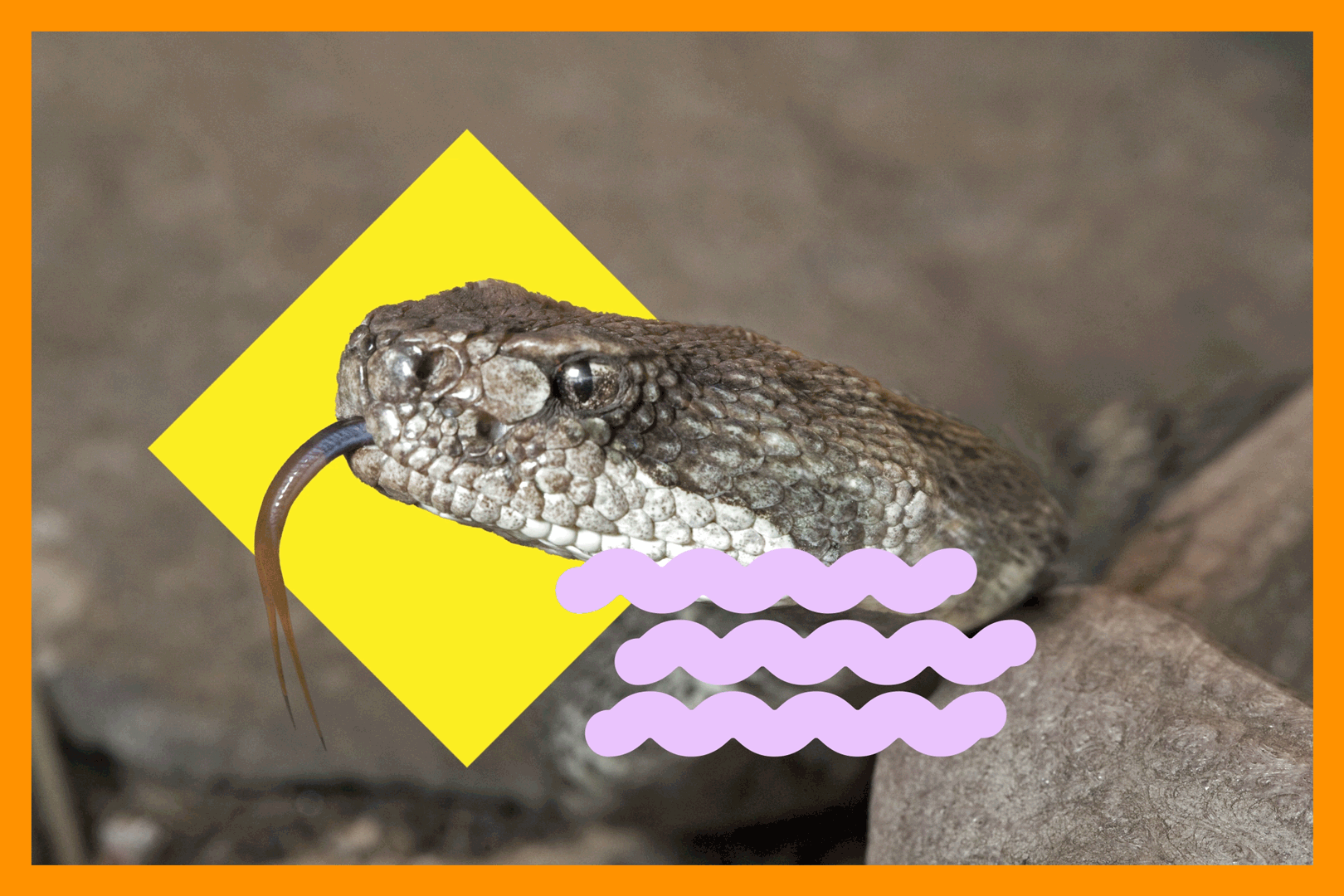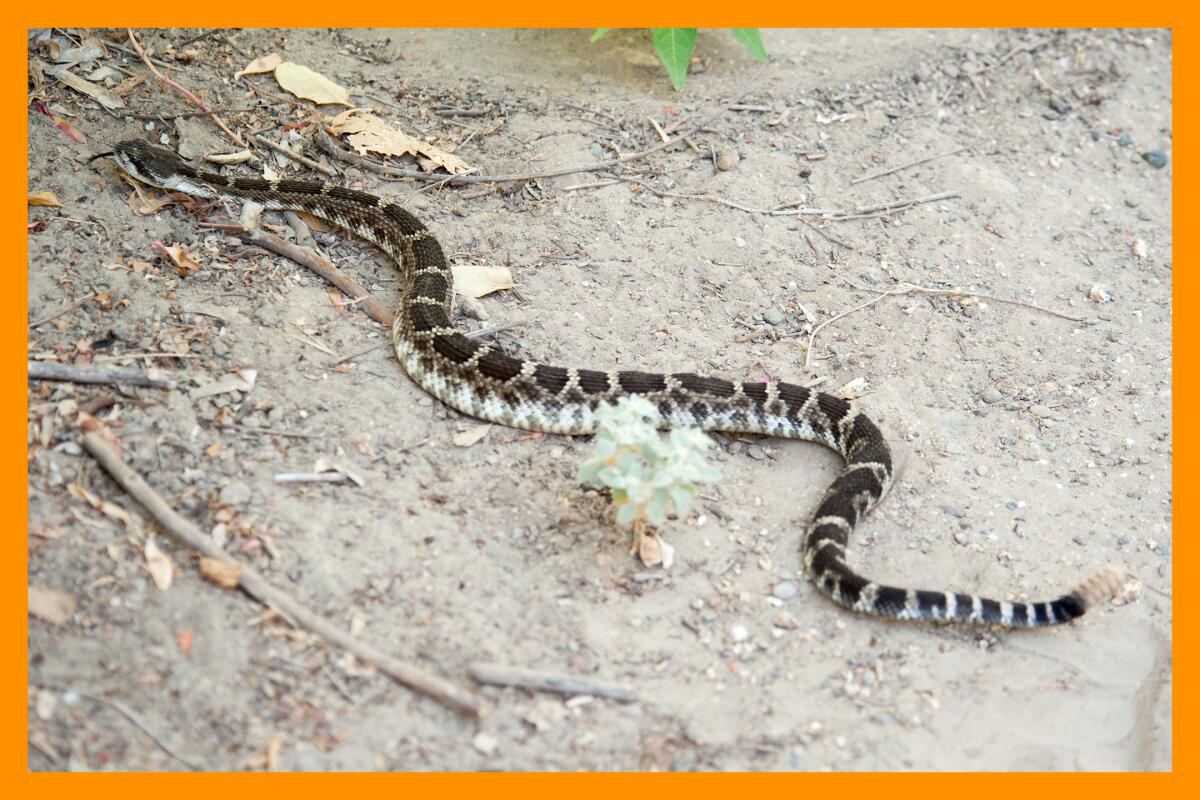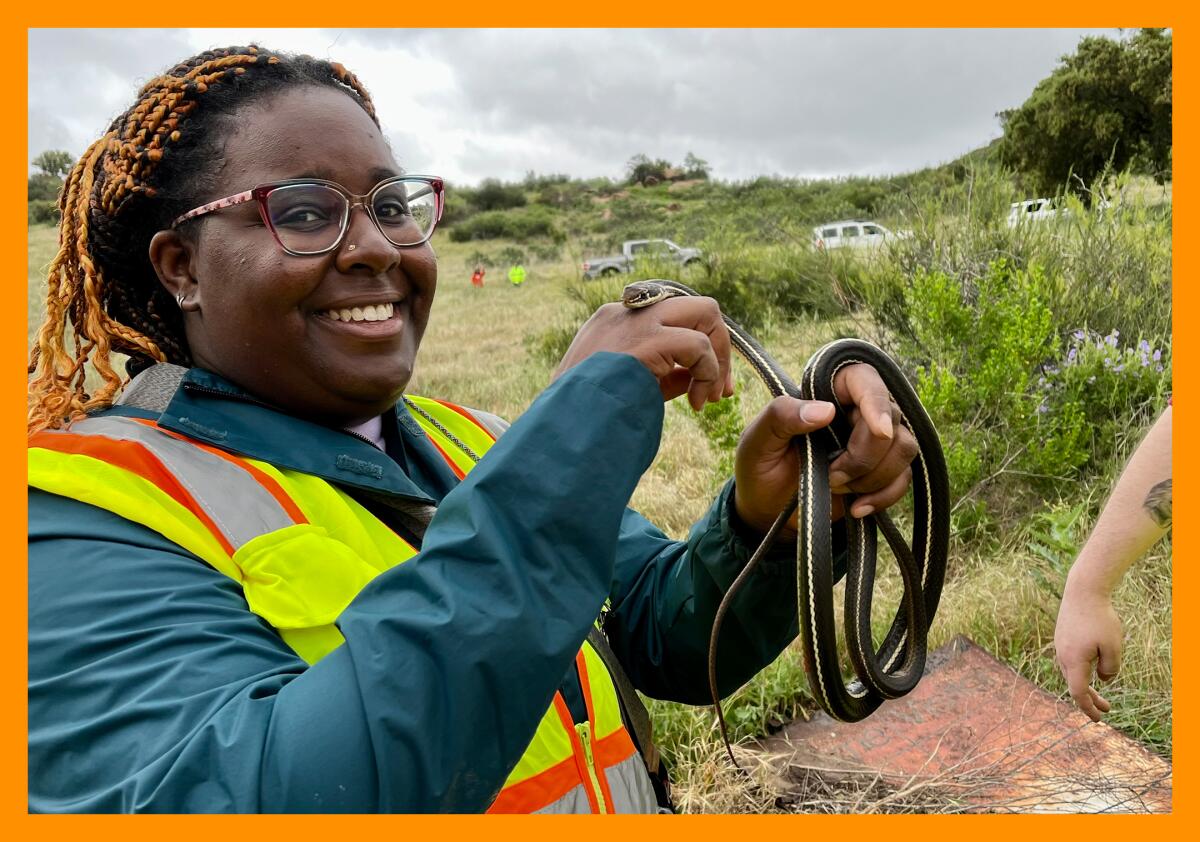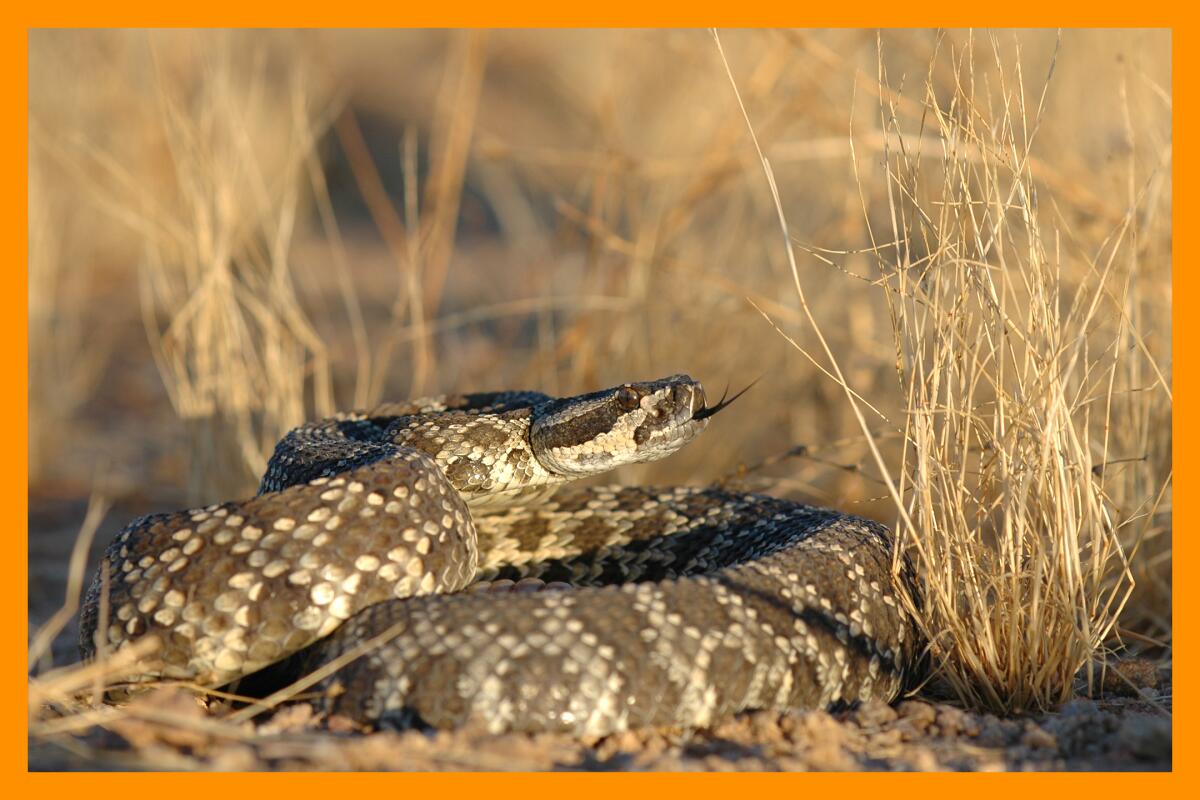4 life-saving tips for when you spot a rattlesnake on the trail

- Share via
My good friend Bob and I were hiking to Strawberry Peak when she abruptly said, “Stop.”
That’s our code for danger. Bob and I hike a lot together, and she frequently rejoices on the trail, like when she sees a butterfly, a lizard or a neat plant. And it always scares me. I hear her and immediately think, “Snake!” (I’m the anxious one)
You are reading The Wild newsletter
Sign up to get expert tips on the best of Southern California's beaches, trails, parks, deserts, forests and mountains in your inbox every Thursday
You may occasionally receive promotional content from the Los Angeles Times.
This time, my nerves did not deceive me.
There we stood, less than a mile into our hike, as an angry rattlesnake lay beneath a short tree rapidly vibrating its eponymous tail. We had to walk past it to keep going.

Our adrenaline was pumping. Before we could decide our next move, another hiker (with an adorable poodle mix) was coming down the trail. We shouted to him that there was a snake. He was unfazed. Older and wiser, this was not his first rodeo. He picked up his dog and slipped past the snake. Then, dog in one arm, he grabbed a large stick with his free hand. He stuck the branch out toward the snake and directed us to walk on his other side until we were in the clear.
That trail angel’s help made all the difference. Further along on our hike that day, others told us the snake had struck at them.
That surprised me. California is home to eight species of rattlesnakes, the most common for our region being the Western Diamondback and Southern Pacific rattlesnakes. But in the hundreds of hours of hiking in the San Gabriel Mountains, this was the only time I’ve ever even seen a rattlesnake there.
(I later learned peak hiking season runs parallel to rattlesnake season, from about April to October, when the most people and snakes are outdoors, and health officials see the most bites.)
After the encounter, I realized I was maybe unreasonably afraid of rattlesnakes, so I sought out an expert to teach me more about them and, in the process, calm my fears.

L.A.-based herpetologist Earyn McGee is a scientist and public speaker who recently spoke at San Diego Comic-Con. (Subscribe to her newsletter to take part in a weekly #FindThatLizard photo challenge.)
Here are the tips I learned from our conversation.
Tip No. 1: Don’t pick up rattlesnakes
OK, yes, duh, this is an outdoors newsletter, and we’re all good stewards of the woods. But I must point out that the majority of rattlesnake bites come from inexperienced people trying to pick them up. And one reason someone picks up a snake is because they aim to kill it, believing that’s needed for self-protection, McGee said. This is not only harmful to our ecosystem but often dangerous for the person in question.
“That’s when you’re going to get bit, because you’re getting too close to it,” McGee said. She adds that even if someone manages to behead a rattlesnake, it can still flip around and bite you.
Although a mammal dies almost immediately after losing its head, a snake doesn’t need as much oxygen to stay alive and could live minutes to hours after being decapitated, according to David Penning, an assistant professor of biology at Missouri Southern State University. So, yes, even a dead snake can have a bite reflex — for hours.
Tip No. 2: Don’t think of rattlesnakes as ‘aggressive’
In the 2006 camp thriller “Snakes on a Plane,” there’s that famous line from actor Samuel L. Jackson regarding what he’d like to be done regarding the snakes on his airplane. You know it. Or what about the 1997 classic “Anaconda,” where J-Lo famously says, “Snakes don’t eat people.” There are countless western films featuring characters bitten by rattlers.
Hollywood — and hey, perhaps the news media — have historically made villains out of snakes, including rattlesnakes. But there are few cases of unprovoked rattlesnake attacks on humans, McGee said.
As the L.A. County Natural History Museum points out, about 8,000 people in the U.S. are bitten each year by venomous snakes. Statistically, it says, “You are 6 times more likely to die from a lightning strike or a dog attack, 8 times more likely to die from a TV set or other large furniture falling on you, 14 times more likely to die falling out of a tree, and 95 times more likely to die falling off a ladder.”
Secondly, every snake is different. People don’t necessarily think of reptiles as having personalities, but they do, McGee said. (In the science world, this is called a flight response, the distance between you and the animal that it takes for that animal to react. McGee said she calls it “personality” to better communicate the idea.)
“Some are going to be more shy, and they’re going to be quicker to rattle at you or try to get away, whereas others are going to be more bold,” McGee said. “But, for the most part, they don’t want to engage with us because we are predators.”
McGee encourages people to think about it from the snake’s perspective: What would be the point of it wasting energy and venom to bite something that they perceive might eat them, when they could use crypsis — their ability to blend into their environment — to hide?
Generally, rattlesnakes will do their best not to engage with you. But if one is moving toward you, don’t assume it’s to attack you.
“If a rattlesnake is coming in your direction, it might be a little bit more bold, and you’re just in the direction that it wants to go in,” McGee said. “So, step to the side of the direction that it’s heading so that way it can go past you.”
Tip No. 3: Do not throw things at a rattlesnake
If you encounter a rattlesnake in the wild, it likely knows you’re there. The reptiles have a heightened sense of touch and feel our vibrations through the ground long before we walk near them. Throwing something at a snake will not succeed in getting it to move but will annoy it.
“If somebody threw a rock at me, that would piss me off even more,” McGee said. “And then what happens when it coils up right in the middle of the trail, and it’s not wide enough to get past? Now you’ve got an angry coiled-up snake.”
And you’ve created a danger for the next hiker. If the trail is wide enough, McGee said, go as far as you safely can around the snake, preferably around its back end to avoid getting bit. If the trail is narrow, you have two options: Turn around and call it a day, or find one or two sticks at least twice the length of the snake, and use them to lightly nudge it away from your path. McGee said the stick length is important because rattlesnakes can strike from about half their body length.
Your goal should be to motivate the snake to move off the trail in a direction away from future hikers, “and preferably in the direction it looks like it’s going,” McGee said. “Because if it’s going left to right, and you’re herding it back to the left ... at some point it’s going to come back around to go to the right.”

Emphasis on gently. “A nice little tap,” McGee specifies, noting the snake could get mad, but often, they leave because a predator (you) is nearby.
If this doesn’t work, then ask yourself: “How badly do you want to go up the rest of the trail?” McGee said. “If you cannot successfully get it to move off the trail, either sit there and wait for someone who can, or turn around.”
Tip No. 4: Be mindful where you step
Even though snakes might detect you’re in the area, McGee suggests still letting them know you’re around.
I like to lightly stomp my feet before entering a narrow or overgrown section of a trail to alert critters of my presence. I’m also mindful when I encounter parts of the trail where snakes might be taking shelter. When I hike among manzanitas, I watch where I’m stepping, as the small red-barked trees provide shade to critters, including snakes. I look around a log that’s fallen on a trail before stepping over it. I also proceed carefully through areas with a lot of fallen or chopped timber. This not only helps the snakes — it also helps us remain mindful of where we are.
(Recently, a friend who was backpacking along the Gabrielino Trail took a step and thought, “Why is the ground squishy?” Then, panic set in. They’d stepped on a rattlesnake. The snake did not immediately react — which is apparently common.)

It’s my hope that these tips will help you more peacefully coexist with the snakes on L.A.’s trails. Rattlesnakes are objectively not cute like California’s black bears. (If not friend, why friend-shaped?) They don’t possess the majestic allure of the mountain lion or great horned owl. But when we don’t understand or appreciate an animal, that leaves it at risk of not being protected. It can normalize violence toward it.
“Rattlesnakes do play a really important part in our ecosystems,” McGee said. “People like not having rodents in their homes and other pests. Rattlesnakes are one of our main ecosystem cleanup machines for things like that. They keep other animal populations in check ... and we should be thanking them for the ecosystem services that they do for us.”
Next time you see a rattlesnake on the trail, try to approach your next move from a place of respect, not fear. I plan to do the same.

3 things to do

1. Celebrate the L.A. River at L.A. State Historic Park
Join the Friends of the Los Angeles River for its annual River Fest, a free open-air community festival from 3 to 9 p.m. Sunday at the serene L.A. State Historic Park. Enjoy live performances, an art gallery and marketplace, along with environmental-themed activities for children and adults and fare from local food trucks. Learn more and register at folar.org.
2. Have a rootin’ tootin’ time at Vasquez Rocks
Grab your boots and scoot on over to “Fireside Night: A Celebration of Western Songs” from 6 to 8:30 p.m. Sunday at Vasquez Rocks Natural Area, an L.A. County park in the high desert near Agua Dulce Springs. This free family-friendly event will feature live music, s’mores around the campfire, booths and food trucks. Registration is not required, but organizers recommend you bring a camp chair (and picnic, if you’d like). Donations to help pay for park improvements are welcome. For more information, visit the park’s Instagram page. Happy trails, partner!
3. Flaunt your best Pride hiking fits in Ventura
To celebrate Ventura County’s LGBTQ+ Pride weekend, the Ventura Land Trust will host a 2- to 3-mile hike from 6 to 7:30 p.m. on Thursday, Aug. 15, through Harmon Canyon Preserve. Naturalist educators will lead the hike through Ventura’s largest nature preserve. Land trust leaders will share natural and cultural details about the preserve. Comfortable, closed-toe shoes, a hat and sunglasses are recommended. Also, bring water. And, as everyone loves a rainbow, organizers note you should “wear your Pride fits.” Please note that parking is limited, so arrive early. Reserve a spot on eventbrite.com.

The must-read

I love hiking with my dog. Has there been an edition of the Wild where I haven’t mentioned Maggie? She’s been my constant companion in the seven years that I’ve hiked our local mountain ranges. But sometimes, it’s just too hot to bring her. Times investigative intern Neenma Ebeledike wrote a helpful guide about how to keep your pet safe during hot weather.
It includes a great tip for hikers: “If you are concerned about the ground being too hot, try touching it with your bare hands,” says Dr. Whitney Miller, chief veterinarian at Petco. “If you can’t hold your hand on the pavement for more than seven seconds, then it is too hot for animal paws.” That includes dirt too!
Happy adventuring,

P.S.
Next time you’re hosting a guest who wants to hike, I’ve got you covered. I rounded up the best trails for every type of visitor you could possibly think of. It was inspired by my family and friends, including my mom, who is always down for a little adventure.
Also, you may have heard that the Perseid meteor shower will be visible this weekend. Times staff writer Jireh Deng covered how you can see this blissful sky parade near L.A.
For more insider tips on Southern California’s beaches, trails and parks, check out past editions of The Wild. And to view this newsletter in your browser, click here.
Sign up for The Wild
We’ll help you find the best places to hike, bike and run, as well as the perfect silent spots for meditation and yoga.
You may occasionally receive promotional content from the Los Angeles Times.




